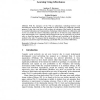293 search results - page 22 / 59 » Design of Experiments via Information Theory |
JUCS
2011
12 years 10 months ago
2011
: With the emergence of the Web 2.0 phenomena, technology-assisted social networking has become the norm. The potential of social software for collaborative learning purposes is cl...
WSC
2007
13 years 9 months ago
2007
We consider the problem of selecting the best system using simulation-based ordinal optimization. This problem has been studied mostly in the context of light-tailed distributions...
ICFP
2003
ACM
14 years 7 months ago
2003
ACM
FreshML extends ML with elegant and practical constructs for declaring and manipulating syntactical data involving statically scoped binding operations. User-declared FreshML data...
MOBIHOC
2008
ACM
14 years 7 months ago
2008
ACM
In order to better understand human and animal mobility and its potential effects on Mobile Ad-Hoc networks and Delay-Tolerant Networks, many researchers have conducted experiment...
CHI
2009
ACM
14 years 8 months ago
2009
ACM
User-Centered Design is surprisingly difficult. One of the biggest issues, certainly for those with no HCI or usability experience, is a lack of appreciation of how users think an...


